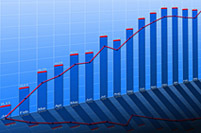Readers of their company’s monthly financial reports typically see an income statement comparing the most recent month’s activity with the same month a year ago, the immediate prior month, or – for the truly enlightened managers – a budget for the month. All sounds normal and reasonable. Except for one awareness the reader will never get unless they have a photographic memory.
 The Risk: in all these cases there is a flaw in the lone comparison that can prove dangerous over time: they overlook the fact that a small variance, a minor deterioration from the prior period, a tolerable budget variance, if repeated over a series of past and future periods, can become a major surprise when taken cumulatively. When the surprise is a pleasant one, everyone can laugh and say “How weird we didn’t see that earlier.” When the surprise is unpleasant, however, the tendency is to begin a frantic search for answers: “How did this happen?” “When did this happen?” “Why didn’t we know it was happening?” “Who’s responsible for this?”
The Risk: in all these cases there is a flaw in the lone comparison that can prove dangerous over time: they overlook the fact that a small variance, a minor deterioration from the prior period, a tolerable budget variance, if repeated over a series of past and future periods, can become a major surprise when taken cumulatively. When the surprise is a pleasant one, everyone can laugh and say “How weird we didn’t see that earlier.” When the surprise is unpleasant, however, the tendency is to begin a frantic search for answers: “How did this happen?” “When did this happen?” “Why didn’t we know it was happening?” “Who’s responsible for this?”
One possible solution? A comparative report that shows a series of these measurements over consecutive periods. Trends are most valuable when they give us clues to the future. In high school physics many of us learned the principles of centrifugal force: an object in motion tends to continue in motion in the same direction. Of course, the object your teacher used to make her point didn’t have COVID, market forces, interest rates, recessions, and human emotions to bump it around, or its path would have been more erratic. So, too, the path of many of our economic indicators is often erratic, but that doesn’t change the validity of tracking their trends to begin to estimate where they might go in the future.
A company whose costs are rising slowly and steadily because it doesn’t effectively control them will likely continue to see its cost rise until it takes some action to disrupt the trend. Human nature being what it is, costs are more likely to rise without controls than they are to fall of their own weight, so studying cost trends is useful to enable managers to identify those trends soon enough to keep the cumulative effect within acceptable limits.
So what should you do? Put a trend report in your monthly financial statement package. It should be an expanded version of your income statement. It should present data for the past 6 to 12 months, month by month, side by side, on one page. Our clients often use 13 months to see how the year-ago month compares to the current month. Check these out monthly and notice how much more you can see. If you really want to keep on top of this stuff, add a cash flow statement in the same format.
So, the value of trend reports: to enable you to predict the likely future performance of some key metric. Sound too iffy for you? Try comparing it to the alternative: guessing.
© 2024 CFO For Rent - Western Management Associates. All rights reserved. Website by Avodah Web Solutions.